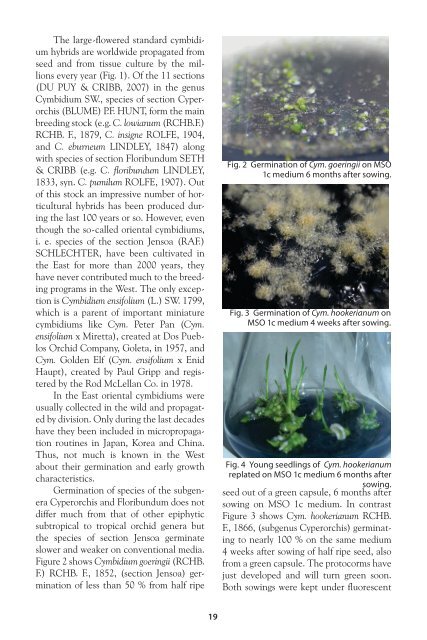CSA-Journal-2016-04
You also want an ePaper? Increase the reach of your titles
YUMPU automatically turns print PDFs into web optimized ePapers that Google loves.
The large-flowered standard cymbidium<br />
hybrids are worldwide propagated from<br />
seed and from tissue culture by the millions<br />
every year (Fig. 1). Of the 11 sections<br />
(DU PUY & CRIBB, 2007) in the genus<br />
Cymbidium SW., species of section Cyperorchis<br />
(BLUME) P.F. HUNT, form the main<br />
breeding stock (e.g. C. lowianum (RCHB.F.)<br />
RCHB. F., 1879, C. insigne ROLFE, 19<strong>04</strong>,<br />
and C. eburneum LINDLEY, 1847) along<br />
with species of section Floribundum SETH<br />
& CRIBB (e.g. C. floribundum LINDLEY,<br />
1833, syn. C. pumilum ROLFE, 1907). Out<br />
of this stock an impressive number of horticultural<br />
hybrids has been produced during<br />
the last 100 years or so. However, even<br />
though the so-called oriental cymbidiums,<br />
i. e. species of the section Jensoa (RAF.)<br />
SCHLECHTER, have been cultivated in<br />
the East for more than 2000 years, they<br />
have never contributed much to the breeding<br />
programs in the West. The only exception<br />
is Cymbidium ensifolium (L.) SW. 1799,<br />
which is a parent of important miniature<br />
cymbidiums like Cym. Peter Pan (Cym.<br />
ensifolium x Miretta), created at Dos Pueblos<br />
Orchid Company, Goleta, in 1957, and<br />
Cym. Golden Elf (Cym. ensifolium x Enid<br />
Haupt), created by Paul Gripp and registered<br />
by the Rod McLellan Co. in 1978.<br />
In the East oriental cymbidiums were<br />
usually collected in the wild and propagated<br />
by division. Only during the last decades<br />
have they been included in micropropagation<br />
routines in Japan, Korea and China.<br />
Thus, not much is known in the West<br />
about their germination and early growth<br />
characteristics.<br />
Germination of species of the subgenera<br />
Cyperorchis and Floribundum does not<br />
differ much from that of other epiphytic<br />
subtropical to tropical orchid genera but<br />
the species of section Jensoa germinate<br />
slower and weaker on conventional media.<br />
Figure 2 shows Cymbidium goeringii (RCHB.<br />
F.) RCHB. F., 1852, (section Jensoa) germination<br />
of less than 50 % from half ripe<br />
Fig. 2 Germination of Cym. goeringii on MSO<br />
1c medium 6 months after sowing.<br />
Fig. 3 Germination of Cym. hookerianum on<br />
MSO 1c medium 4 weeks after sowing.<br />
Fig. 4 Young seedlings of Cym. hookerianum<br />
replated on MSO 1c medium 6 months after<br />
sowing.<br />
seed out of a green capsule, 6 months after<br />
sowing on MSO 1c medium. In contrast<br />
Figure 3 shows Cym. hookerianum RCHB.<br />
F., 1866, (subgenus Cyperorchis) germinating<br />
to nearly 100 % on the same medium<br />
4 weeks after sowing of half ripe seed, also<br />
from a green capsule. The protocorms have<br />
just developed and will turn green soon.<br />
Both sowings were kept under fluorescent<br />
19


